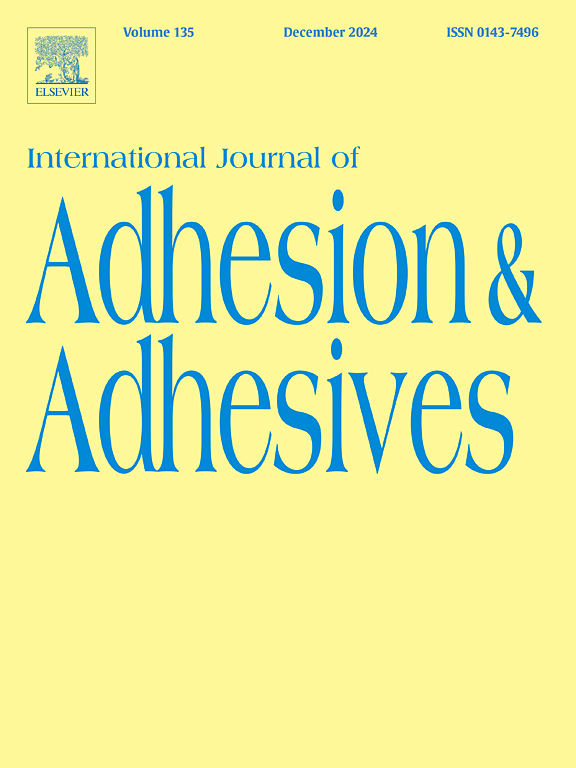Are glass ionomer cements bioactive? Analysis of ions release, pH, hydroxyapatite nanoprecursors formation, antibacterial activity, and cytotoxicity
IF 3.2
3区 材料科学
Q2 ENGINEERING, CHEMICAL
International Journal of Adhesion and Adhesives
Pub Date : 2024-10-04
DOI:10.1016/j.ijadhadh.2024.103845
引用次数: 0
Abstract
Objective
This study assessed the release of F−, Ca+2, PO4−3, alkalinizing activity, cytotoxicity, antibacterial activity, and the hydroxyapatite nanoprecursor formation of six commercial glass ionomer cements (GICs).
Materials and methods
Bioglass (Biodinâmica), Gold label 9 (GC), Vitrofil (DFL), Maxxion (FGM), Vidrion (SS WHITE) and Ionglass (Maquira) were evaluated. pH analysis was performed at different times in initial pH (pHi) 4 and 7 for 28 days. At day-28, the release of Ca+2, PO4−3 and F− was analyzed. Fibroblastic cells were used for cytotoxicity tests. Samples were evaluated at 24, 48 and 72 h. The hydroxyapatite precipitate formation was analyzed using SEM/EDS, FTIR/ATR and XRD, after 28 days. S. mutans biofilms were cultured over GIC disks to antibacterial activity assessment.
Results
pH of all GIC were acidic over 28 days. Bioglass had greater F− release when compared to Gold Label (p < 0.05), at pHi 4. At pHi 7, there was no difference on F− release between GICs. Ionglass and Vitro fill had the highest Ca+2 and PO4−3 release. SEM indicated the presence of precipitates on the surface of all GICs and FTIR showed the presence of carbonate (1080/1413/1453 cm−1). XRD did not indicate crystalline hydroxyapatite precursors peaks. All GICs presented cytotoxicity when compared to the control group in 72h (p < 0.05). The GICs did not have antibacterial activity against S. mutans (p < 0.05).
Significance
GICs released ions that are important for tooth remineralization. However, GICs showed low pH, cytotoxicity, lack of antibacterial activity and the absence of precursors of hydroxyapatite indicated that materials were not bioactive.
玻璃离子聚合物水门汀具有生物活性吗?离子释放、pH 值、羟基磷灰石纳米前驱体形成、抗菌活性和细胞毒性分析
目的 本研究评估了六种商用玻璃离子水门汀(GIC)的 F-、Ca+2、PO4-3 释放量、碱化活性、细胞毒性、抗菌活性以及羟基磷灰石纳米前驱体的形成。材料和方法对 Bioglass(Biodinâmica)、Gold label 9(GC)、Vitrofil(DFL)、Maxxion(FGM)、Vidrion(SS WHITE)和 Ionglass(Maquira)进行了评估。 在初始 pH 值(pHi)为 4 和 7 的不同时间进行 pH 值分析,持续 28 天。在第 28 天,分析了 Ca+2、PO4-3 和 F- 的释放情况。成纤维细胞用于细胞毒性测试。28 天后,使用 SEM/EDS、FTIR/ATR 和 XRD 分析羟基磷灰石沉淀的形成。在 GIC 盘上培养 S. mutans 生物膜,进行抗菌活性评估。在 pHi 4 时,Bioglass 比 Gold Label 释放出更多的 F-(p <0.05)。在 pHi 7 时,不同 GIC 的 F- 释放量没有差异。Ionglass 和 Vitro fill 的 Ca+2 和 PO4-3 释放量最高。扫描电镜显示所有 GIC 表面都有沉淀物,傅立叶变换红外光谱显示存在碳酸盐(1080/1413/1453 cm-1)。XRD 没有显示出羟基磷灰石前体的结晶峰。与对照组相比,所有 GIC 在 72 小时内都具有细胞毒性(p < 0.05)。意义GICs 释放的离子对牙齿再矿化非常重要。然而,GICs 显示出低 pH 值、细胞毒性、缺乏抗菌活性以及羟基磷灰石前体的缺失,这表明材料不具有生物活性。
本文章由计算机程序翻译,如有差异,请以英文原文为准。
求助全文
约1分钟内获得全文
求助全文
来源期刊

International Journal of Adhesion and Adhesives
工程技术-材料科学:综合
CiteScore
6.90
自引率
8.80%
发文量
200
审稿时长
8.3 months
期刊介绍:
The International Journal of Adhesion and Adhesives draws together the many aspects of the science and technology of adhesive materials, from fundamental research and development work to industrial applications. Subject areas covered include: interfacial interactions, surface chemistry, methods of testing, accumulation of test data on physical and mechanical properties, environmental effects, new adhesive materials, sealants, design of bonded joints, and manufacturing technology.
 求助内容:
求助内容: 应助结果提醒方式:
应助结果提醒方式:


